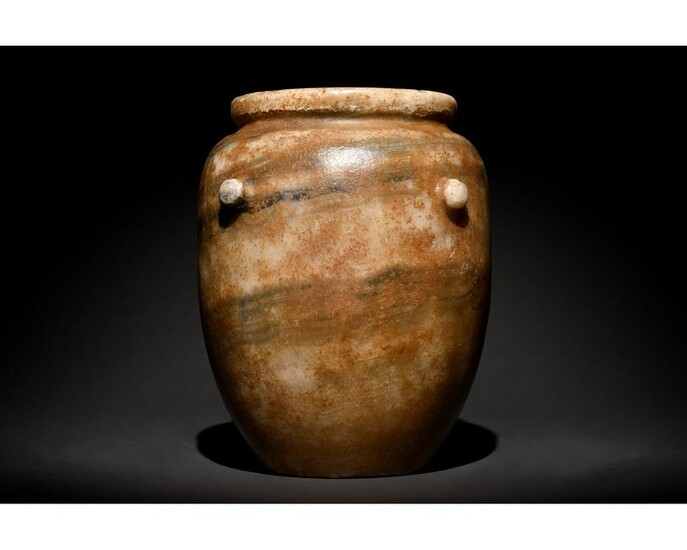ANCIENT BACTRIAN ALABASTER VESSEL
C.3000-2000 BC. Bactrian. Beautiful, large alabaster vessel with amber-coloured slip and dark bands swirling around its body. Clearly, the craftsman knew how to take advantage of the swirling bands of colour of the alabaster to give a sense of movement as a decorative element on the vessel. The shoulder are presented with knobs and topped with a flared rim. Alabaster was a precious material, widely traded in the region from the 4th millennium BCE onward.The purpose of such a vessel is not known. Pieces like this one often came from burials and votive offerings. Along with others that make up the typology of stone vessels, together with the well-known column or circular idols, these are all characteristic of the Bactrian material culture. This piece relates to an ancient culture referred to both as the Bactria-Margiana Archaeological Complex (BCAM) or as the Oxus Civilisation. The Bactria-Margiana culture spread across an area encompassing the modern nations of Turkmenistan, Tajikistan, Uzbekistan and Northern Afghanistan. Flourishing between about 2100 and 1700 BC, it was contemporary with the European Bronze Age, and was characterised by monumental architecture, social complexity and extremely distinctive cultural artefacts that vanish from the record a few centuries after they first appear. Pictographs on seals have been argued to indicate an independently-developed writing system.It was one of many economic and social entities in the vicinity, and was a powerful country due to the exceptional fertility and wealth of its agricultural lands. This in turn gave rise to a complex and multifaceted set of societies with specialist craftsmen who produced luxury materials such as this for the ruling and aristocratic elites. Trade appears to have been important, as Bactrian artefacts appear all over the Persian Gulf as well as in the Iranian Plateau and the Indus Valley. For this reason, the area was fought over from deep prehistory until the Mediaeval period, by the armies of Asia Minor, Greece (Macedonia), India and the Arab States, amongst others.Through local stone carvers inhabiting the regions of Margiana and Bactria experienced no shortage in material; the main raw material was soft steatite or a dark soapstone, but also various kinds of marble and white-veined alabaster. The main source for these stones, including semi- precious lapis-lazuli, was in Bactria, at Badakhshan in north-western Afghanistan, which provided material not only for the Bactrian and Margian carvers but also farther to the west into Mesopotamia, for the Assyrian kings. Provenance: From the important collection of a London doctor A.R; passed by descent to his son; formerly acquired before 2000 on the UK art market. Size: L:200mm / W:165mm ; 3.9g
[ translate ]View it on
Sale price
Estimate
Time, Location
Auction House
C.3000-2000 BC. Bactrian. Beautiful, large alabaster vessel with amber-coloured slip and dark bands swirling around its body. Clearly, the craftsman knew how to take advantage of the swirling bands of colour of the alabaster to give a sense of movement as a decorative element on the vessel. The shoulder are presented with knobs and topped with a flared rim. Alabaster was a precious material, widely traded in the region from the 4th millennium BCE onward.The purpose of such a vessel is not known. Pieces like this one often came from burials and votive offerings. Along with others that make up the typology of stone vessels, together with the well-known column or circular idols, these are all characteristic of the Bactrian material culture. This piece relates to an ancient culture referred to both as the Bactria-Margiana Archaeological Complex (BCAM) or as the Oxus Civilisation. The Bactria-Margiana culture spread across an area encompassing the modern nations of Turkmenistan, Tajikistan, Uzbekistan and Northern Afghanistan. Flourishing between about 2100 and 1700 BC, it was contemporary with the European Bronze Age, and was characterised by monumental architecture, social complexity and extremely distinctive cultural artefacts that vanish from the record a few centuries after they first appear. Pictographs on seals have been argued to indicate an independently-developed writing system.It was one of many economic and social entities in the vicinity, and was a powerful country due to the exceptional fertility and wealth of its agricultural lands. This in turn gave rise to a complex and multifaceted set of societies with specialist craftsmen who produced luxury materials such as this for the ruling and aristocratic elites. Trade appears to have been important, as Bactrian artefacts appear all over the Persian Gulf as well as in the Iranian Plateau and the Indus Valley. For this reason, the area was fought over from deep prehistory until the Mediaeval period, by the armies of Asia Minor, Greece (Macedonia), India and the Arab States, amongst others.Through local stone carvers inhabiting the regions of Margiana and Bactria experienced no shortage in material; the main raw material was soft steatite or a dark soapstone, but also various kinds of marble and white-veined alabaster. The main source for these stones, including semi- precious lapis-lazuli, was in Bactria, at Badakhshan in north-western Afghanistan, which provided material not only for the Bactrian and Margian carvers but also farther to the west into Mesopotamia, for the Assyrian kings. Provenance: From the important collection of a London doctor A.R; passed by descent to his son; formerly acquired before 2000 on the UK art market. Size: L:200mm / W:165mm ; 3.9g
[ translate ]


